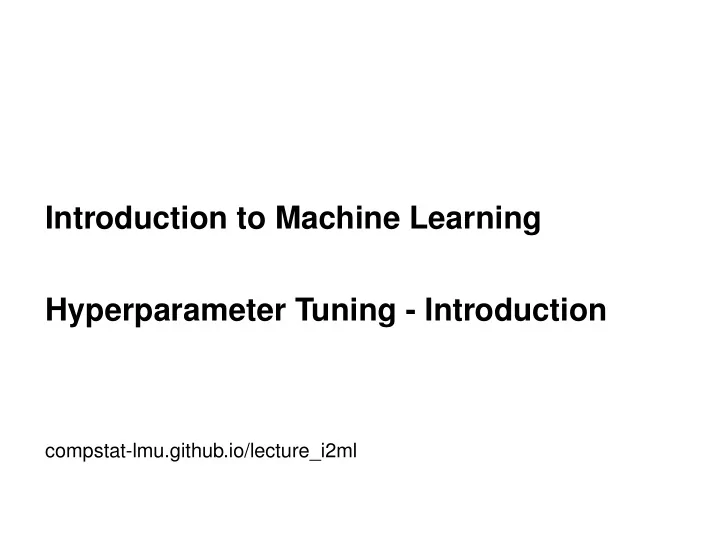

Introduction to Machine Learning Hyperparameter Tuning - Introduction compstat-lmu.github.io/lecture_i2ml
MOTIVATING EXAMPLE Given a dataset, we want to train a classification tree. We feel that a maximum tree depth of 4 has worked out well for us previously, so we decide to set this hyperparameter to 4. The learner ("inducer") I takes the input data, internally performs empirical risk minimization , and returns a fitted tree model ˆ f ( x ) = f ( x , ˆ θ ) of at most depth λ = 4 that minimizes the empirical risk. � c Introduction to Machine Learning – 1 / 6
MOTIVATING EXAMPLE We are actually interested in the generalization performance � � ˆ GE f of the estimated model on new, previously unseen data. We estimate the generalization performance by evaluating the model ˆ f on a test set D test : � � � � � 1 � ˆ y , ˆ = f ( x ) GE D test f L |D test | ( x , y ) ∈D test � c Introduction to Machine Learning – 2 / 6
MOTIVATING EXAMPLE But many ML algorithms are sensitive w.r.t. a good setting of their hyperparameters, and generalization performance might be bad, if we have chosen a suboptimal configuration: The data may be too complex to be modeled by a tree of depth 4 The data may be much simpler than we thought, and a tree of depth 4 overfits = ⇒ algorithmically try out different values for the tree depth. For each maximal depth λ , we have to train the model to completion and evaluate its performance on the test set. We choose the tree depth λ that is optimal w.r.t. the generalization error of the model. � c Introduction to Machine Learning – 3 / 6
MODEL PARAMETERS VS. HYPERPARAMETERS It is critical to understand the difference between model parameters and hyperparameters. Model parameters are optimized during training, typically via loss minimization. They are an output of the training. Examples: The splits and terminal node constants of a tree learner Coefficients θ of a linear model f ( x ) = θ ⊤ x � c Introduction to Machine Learning – 4 / 6
MODEL PARAMETERS VS. HYPERPARAMETERS In contrast, hyperparameters (HPs) are not decided during training. They must be specified before the training, they are an input of the training. Hyperparameters often control the complexity of a model, i.e., how flexible the model is. But they can in principle influence any structural property of a model or computational part of the training process. Examples: The maximum depth of a tree k and which distance measure to use for k -NN the number and maximal order of interactions to be included in a linear regression model � c Introduction to Machine Learning – 5 / 6
TYPES OF HYPERPARAMETERS We summarize all hyperparameters we want to tune over in a vector λ ∈ Λ of (possibly) mixed type. HPs can have different types: Real-valued parameters, e.g.: Minimal error improvement in a tree to accept a split Bandwidths of the kernel density estimates for Naive Bayes Integer parameters, e.g.: Neighborhood size k for k -NN mtry in a random forest Categorical parameters, e.g.: Which split criterion for classification trees? Which distance measure for k -NN? Hyperparameters are often hierarchically dependent on each other, e.g., if we use a kernel-density estimate for Naive Bayes, what is its width? � c Introduction to Machine Learning – 6 / 6
Recommend
More recommend